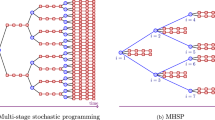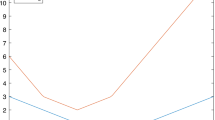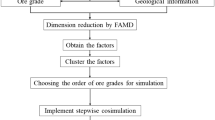Abstract
Solving the ultimate pit problem remains an important and relevant task in open pit mine planning as a subroutine in sophisticated decision processes, parametric analysis, quantifying the impact of geologic uncertainty, approaching more complicated problems such as production scheduling, or as a subproblem in decomposition. Ultimate pit models often contain dozens of millions of blocks and hundreds of millions of precedence constraints, and they may need to be solved hundreds or even thousands of times. These requirements can quickly overwhelm existing ultimate pit solvers. This paper introduces MineFlow: an open-source C++ library providing efficient and flexible precedence schemes and a stripped down pseudoflow-based solver. In a computational comparison with five modern commercial packages, we show that MineFlow computes consistently identical results in a fraction of the time; for example, with MineFlow a block model containing 16 million blocks is processed in nine seconds, whereas the fastest commercial alternative takes two and a half minutes. These improvements are realized by using implicit precedence schemes and by modifying slightly the conventional pseudoflow algorithm. Additionally, we present a compact notation for the pseudoflow algorithm to assist educators in presenting the latest in ultimate pit optimization.











Similar content being viewed by others
Availability of Data and Materials
One of the datasets used during the study is not available due to confidentiality issues. The remaining data are available from the corresponding author.
Code Availability
All code used to generate precedence graphs and compute ultimate pits is available from the corresponding author and at the following link: https://github.com/MineFlowCSM/MineFlow
References
Ahuja, R. K., Magnanti, T. L., & Orlin, J. B. (1988). Network flows: Theory, algorithms, and applications. Pearson.
Bienstock, D., & Zuckerberg, M. (2009). A new LP algorithm for precedence constrained production scheduling. In Optimization Online (pp. 1–33).
Caccetta, L., & Giannini, L. M. (1988). The generation of minimum search patterns in the optimum design of open pit mines. In AusIMM Bull Proc (Vol. 293, No. 5, pp. 57–61).
Chandran, B. G., & Hochbaum, D. S. (2009). A computational study of the pseudoflow and push-relabel algorithms for the maximum flow problem. Operations Research, 57(2), 358–376.
Chen, T. (1976). 3D pit design with variable wall slope capabilities. In 14th symposium on the application of computers and operations research in the mineral industries (APCOM).
Darling, P. (Ed.). (2011). SME mining engineering handbook. In Society for mining, metallurgy, and exploration (Vol. 1).
Deutsch, M., González, E., & Williams, M. (2015). Using simulation to quantify uncertainty in ultimate-pit limits and inform infrastructure placement. Mining Engineering, 67(12), 49–55. https://doi.org/10.19150/me.6411
Díaz, A. B., Álvarez, I. D., Fernández, C. C., Krzemień, A., & Rodríguez, F. J. I. (2021). Calculating ultimate pit limits and determining pushbacks in open-pit mining projects. Resources Policy, 72, 102058.
Ford, L. R., Jr., & Fulkerson, D. R. (1962). Flows in networks. Princeton University Press. https://doi.org/10.1515/9781400875184
Gilani, S. O., & Sattarvand, J. (2015). A new heuristic non-linear approach for modeling the variable slope angles in open pit mine planning algorithms. Acta Montanistica Slovaca, 20(4), 251–259.
Goldberg, A. V., & Tarjan, R. E. (1988). A new approach to the maximum-flow problem. Journal of the ACM (JACM), 35(4), 921–940.
Hochbaum, D. S. (2001). A new—Old algorithm for minimum-cut and maximum-flow in closure graphs. Networks: an International Journal, 37(4), 171–193.
Hochbaum, D. S. (2008). The pseudoflow algorithm: A new algorithm for the maximum-flow problem. Operations Research, 56(4), 992–1009.
Johnson, T. B. (1968). Optimum open pit mine production scheduling (No. ORC-68–11). California Univ Berkeley Operations Research Center.
Khalokakaie, R., Dowd, P. A., & Fowell, R. J. (2000). Lerchs-Grossmann algorithm with variable slope angles. Mining Technology, 109(2), 77–85.
Korobov, S. (1974). Method for determining optimal open pit limits. Ecole Polytechnique de l’Université de Montréal. Technical report EP74.
Lerchs, H., & Grossmann, I. (1965). Optimum design of open-pit mines. Operations Research, 12, B59.
Mwangi, A. D., Jianhua, Z., Gang, H., Kasomo, R. M., & Innocent, M. M. (2020). Ultimate pit limit optimization methods in open pit mines: A review. Journal of Mining Science, 56(4), 588–602.
Pana, M. T. (1965). The simulation approach to open pit design. In 5th symposium on the application of computers and operations research in the mineral industries (APCOM) (pp. 127–138).
Zhao, Y. (1992). Algorithms for optimum design and planning of open-pit mines. The University of Arizona
Acknowledgments
We thank Dr Marcelo Godoy for sponsoring this project. We also thank Dr Conor Meagher and Dr Ryan Goodfellow, also from Newmont, for useful discussions. Additionally, we thank Lee Jornet Zamalloa Llerena, Graduate Student from the Mining Department at Colorado School of Mines, for assisting us in data conversion and running the commercial packages with the different datasets.
Funding
This work was funded by Newmont Corporation.
Author information
Authors and Affiliations
Corresponding author
Ethics declarations
Conflicts of Interest
The authors have no relevant financial or non-financial conflicts of interests to disclose.
Rights and permissions
About this article
Cite this article
Deutsch, M., Dağdelen, K. & Johnson, T. An Open-Source Program for Efficiently Computing Ultimate Pit Limits: MineFlow. Nat Resour Res 31, 1175–1187 (2022). https://doi.org/10.1007/s11053-022-10035-w
Received:
Accepted:
Published:
Issue Date:
DOI: https://doi.org/10.1007/s11053-022-10035-w




